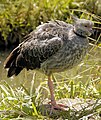Southern screamer
| Southern screamer | |
|---|---|

| |
| in the Pantanal, Brazil | |
| Scientific classification | |
| Kingdom: | Animalia |
| Phylum: | Chordata |
| Class: | Aves |
| Order: | Anseriformes |
| Family: | Anhimidae |
| Genus: | Chauna |
| Species: | C. torquata
|
| Binomial name | |
| Chauna torquata Oken, 1816
| |

| |
| Distribution map | |
The southern screamer (Chauna torquata), also known as the crested screamer, belongs to the order Anseriformes. It is found in southeastern Peru, northern Bolivia, Paraguay, southern Brazil, Uruguay and northern Argentina.[2] Its diet consists of plants stems, seeds, leaves, and, rarely, small animals.
Description[]
The southern screamer averages 81–95 cm (32–37 in) long and weighs 3–5 kg (6.6–11.0 lb).[3] They are the heaviest, although not necessarily the longest, of the three screamers.[4] The wingspan is around 170 cm (67 in).[5] Among standard measurements, the wing chord measures 54 cm (21 in), the tail 23.2 cm (9.1 in), the culmen 4.5 cm (1.8 in) and the long tarsus 11 cm (4.3 in).[6] It lives in tropical and sub-tropical swamps, estuaries and watersides.
Behaviour and ecology[]
The southern screamer is a good swimmer, having partially webbed feet, but prefers to move on the ground. The bony spurs on its wings are used for protection against rival screamers and other enemies. Although it is non-migratory, it is an excellent flier. It lives in large flocks, feeding on the ground in grasslands and cultivated fields until nesting season, when birds pair off.[7] Their unfussy diet makes them amenable to domestication and they make excellent guard animals due to their loud screams.
Breeding[]
The southern screamer establishes monogamous relationships that last its lifetime, estimated to be 15 years. Courtship involves loud calling by both sexes, which can be heard up to two miles away.[7] For the nest the couple makes a big platform of reeds, straws, and other aquatic plants in an inaccessible place near water. The female lays between two and seven white eggs. The couple share incubation, which takes 43 to 46 days. Chicks leave the nest as soon as they hatch, but the parents care for them for several weeks. The fledging period takes 8 to 14 weeks.
Gallery[]
| Wikimedia Commons has media related to Chauna torquata. |

On a nest at Iguazu Bird Park, Brazil

Sitting on 2 eggs.

Family in Rio Grande do Sul, Brazil
Chicks

There are two color phases, light and dark.[7]

Head

At Artis Zoo, Netherlands
See also[]
- Horned screamer, Anhima cornuta
- Northern screamer or Black-necked screamer, Chauna chavaria
References[]
- ^ BirdLife International (2016). "Chauna torquata". IUCN Red List of Threatened Species. 2016: e.T22679729A92826769. doi:10.2305/IUCN.UK.2016-3.RLTS.T22679729A92826769.en. Retrieved 12 November 2021.
- ^ Clements, James, (2007) The Clements Checklist of the Birds of the World, Cornell University Press, Ithaca
- ^ "Southern Screamer - Chauna torquata". oiseaux.net. Retrieved 23 September 2008.
- ^ del Hoyo, Elliott & Sargatal. Handbook of Birds of the World, Volume 1 Ostrich to Ducks. ISBN 84-87334-10-5
- ^ Screamer (2011).
- ^ of Birds in the British Museum
- ^ a b c "Southern Crested Screamer". Sacramento Zoo. Retrieved 30 December 2009.[permanent dead link]
- IUCN Red List least concern species
- Anhimidae
- Birds of South America
- Birds described in 1816








